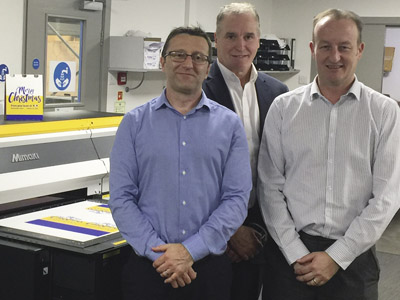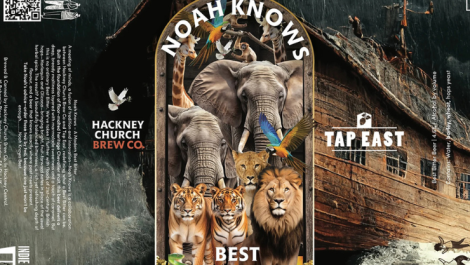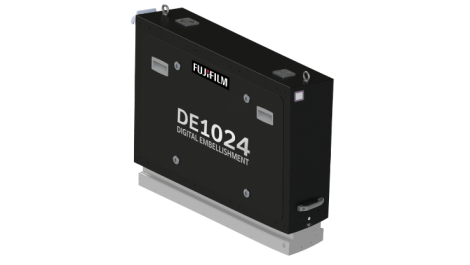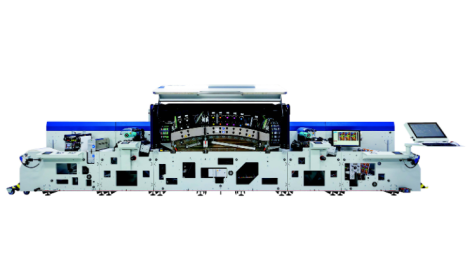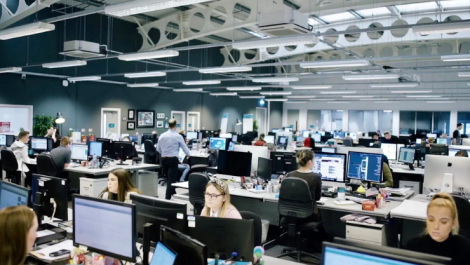(L-R) Pre-production manager Phil Knight with Production Print Direct sales manager for wide format products, Steve Beswick, and Falconer managing director, Richard Martin
Wide format printers have an important role to play in the labels and packaging sector, either used to produce samples or packaging mock-ups, or for very short runs. Neel Madsen looks at the latest launches and installations.
The versatility of wide format machines means that you can find them in many different printing environments in the packaging industry; from flexo pre-press houses and design studios to label printers and packaging companies. Some are used for straightforward colour proofing or for samples, others for short runs of folding cartons, corrugated boxes or packaging displays.
Carton proof
Yorkshire-based Falconer Print & Packaging recently installed a Mimaki UJF-7151 Plus LED UV flatbed printer from Production Print Direct Limited to improve carton-proofing quality. The company, which was initially looking for a direct-to-substrate printer to improve production of mock-ups for customer proofs, was encouraged by the Mimaki’s potential to print short run jobs not suitable for its Heidelberg press.
‘Not only was the bed size of 710 x 510 mm ideal for the Iggesund board size we use, having the ability to print onto a thickness of up to 153 mm offers us a lot of future flexibility,’ explained managing director Richard Martin. ‘The inks are flexible too, which means that no cracking in the finishing process occurs.’
Established in 1987, Falconer has an annual turnover of £4.5 million and employs 42 people from its location between Leeds and Manchester. It specialises in luxury and pharmaceutical packaging aimed at a wide range of design-led sectors.
‘Our customers’ needs and expectations on turnaround and what we can print on are constantly keeping us on our toes,’ added Mr Martin. ‘The Mimaki has stunning print quality with ink drop placement at 1200 dpi, which is a massive improvement on the toner based kit it replaces. We spec’d it with white and clear inks to give us the full effect for proofs that require spot UV varnish with a very tactile finish.’
‘Falconer had already recognised they needed to improve their proofing capability,’ said Steve Beswick, sales manager for wide format products at Production Print Direct. ‘We ran a few jobs at the Crewe showroom and the UJF-7151 plus offered more than expected, especially being able to lay down multiple layers of process, white and clear using the six staggered print heads, producing a spot UV varnish effect in a single print process.’
In other news, the MkII family of UJF compact UV flatbed printers from Mimaki now comes with a ‘Kebab’ option, which makes it possible to print onto a wide range of cylindrical objects. The Mimaki UJF-3042 MkII is compatible with the Kebab MkII model, while the MkII L model is needed for the UJF-6042MkII and the UJF-7151 Plus printers.
‘Our customers have been very creative in their use of the Kebab option,’ said Mike Horsten, general manager of marketing at Mimaki EMEA. ‘Cosmetics bottles are a good example. With the many different regulatory requirements from country to country, short runs of cosmetics bottles are becoming more common.’
Scalability wins
The Onset X series of UV flatbed printers from Fujifilm and Inca Digital is an scaleable, industrial-sized platform developed for packaging a lrage format displays. It has proved popular with corrugated printing companies and a series of installations have taken place over the past year.
Most recently, Croatian company ProDigital has become the first business in the Balkans to invest in an Onset X1. The corrugated board printer supplies POS display and packaging for a range of high-profile clients across Europe, including many major global brands.
Amongst the criteria for choosing the printer were boosting production efficiency and cutting delivery times. ‘We wanted to be sure we had the fastest machine on the market,’ said CEO Denis Cigir. ‘But we were not prepared to compromise on quality to get there.’
He continued, ‘We viewed the Onset R40LT at Fespa in 2015 and then arranged a special visit to the Fujifilm Advanced Print Technology Centre in Brussels to see the Onset X Series in action earlier this year. We also visited the Fujifilm Speciality Ink Systems headquarters in Broadstairs, in the UK, last winter to attend its series of Corrugated Summits.
‘These experiences, and our corresponding conversations with other press manufacturers and suppliers, convinced us that for ultra-high speed at reliably high quality, the Onset X platform has no equal.’
Mr Cigir also highlights the advantages the printer’s scalable platform provides. He said, ‘We’ve invested in an Onset X1, but we know that we can very easily and cost-effectively scale up our existing platform to an X2 or even an X3, which gives us the potential to achieve production speeds of up to 900 square metres an hour. With our new Onset X, we have invested for the long-term, and have the security of knowing we can easily step our production up to even greater levels when necessary in the future.’
Water advantage
Durst first showed the new Delta WT 250 press for corrugated display and packaging at the International Exhibition for Corrugated and Folding Carton Industry (CCE) in Munich in March. This is the first flatbed, multi-pass digital printing system based on Durst’s Water Technology, which was first announced at Fespa 2015. The wide format machine prints on a range of coated boards for packaging and displays, and the first installation is at Bauernfeind Print & Display in Obergrünburg, in Austria.

The Delta WT 250 from Durst
The family company is an early adopter of digital print and is hoping to increase its €2 million turnover by 25% a year with the new technology. Thomas Bauernfeind, managing director, said, ‘In the past some markets have not been possible because of the odour in certain packaging and other display products using UV ink. But now a whole new world of opportunities has opened up. As one example, one of the world’s major drinks brands has been so impressed that they have started using display packaging products printed on our Delta WT 250 system. It’s odourless, there’s no migration and produces outstanding results.’
Markus Gutmann, Bauernfeind’s key account manager, who has been in the print and packaging industry for 36 years, said, ‘It’s not even now a question or digital or offset. Even an expert can no longer determine the difference, and often the Durst digital quality is superior anyway to offset. The colours are simply outstanding, particularly for vivid and glossy colours.’
Now in full production, the printer is producing typical run of between 100 and 500, but this can easily be 1000. The majority of the direct printing is on coated corrugated boards, as well as some carton and other fibre substrate applications like honeycomb boards.
Read the full March/April issue here.

